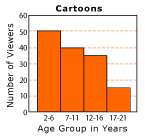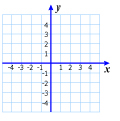A
Acute Angle: An angle with a measure less
than 90º
Addend: Any number that is being
added.
Analog Time: Time displayed on a timepiece
having hour and minute hands.
Area: The measure, in square units, of the
inside of a plane figure.
Array: A rectangular arrangement of
objects in equal rows or columns.
back to top
B
Bar Graph : A graph that uses bars to
show data.

back to top
C
Chord: A line segment whose endpoints are
on a circle.

Circumference: The distance around a
circle.
Combination: A group of items. Placing
these items in a different order does not create a new
combination.
Composite number: A whole number having
more than two factors.
Cone: A solid figure that has a circular
base and one vertex.

Congruent: Having the same size and shape.
EXAMPLE - Congruent angles have the same measure; congruent
segments have the same length.
Cube: (noun) A rectangular solid
having six congruent, square faces.

Cube: (verb) To raise a quantity
or number to the third power. (x)(x)(x)
Cylinder: A three-dimensional figure with
two circular bases, which are parallel and congruent.

back to top
D
Diameter: A line segment that has
endpoints on a circle and passes through the center of the
circle.

Difference: The answer in a subtraction
problem. EXAMPLE: 8 - 3 = 5; 5 is the difference.
back to top
E
Edge: The line segment where two faces of
a solid figure meet.
Equation: A statement that two
mathematical expressions are equal.
Equilateral triangle: A triangle with all
three sides of equal length. The angles of an equilateral triangle
are always 60°

Equivalent: Having the same value.
Expanded notation: A way to write numbers
that shows the value of each digit
(EXAMPLE: 4372 = 4000+300+70+2).
Expression: A variable, or any combination
of numbers, variables, and symbols that represents a mathematical
relationship (EXAMPLE: 24 x 2 + 5 or 4a - 9).
back to top
F
Face: A plane figure that serves as one
side of a solid figure.
Fact family: A set of related addition and
subtraction, or multiplication and division equations using the
same numbers (EXAMPLE: 6+9=15, 15-9=6, 9+6=15, 15-6=9).
Factor: A whole number that divides evenly
into another whole number (EXAMPLE: 1, 3, 5, and 15 are factors of
15).
Function: A relation in which every input
value has a unique output value.
back to top
G
Greatest common factor (GCF): The largest
factor that 2 or more numbers have in common.
back to top
H
Heptagon: A polygon with 7 sides.
Hexagon: A polygon with 6 sides.

Histogram: A bar graph in which the labels
for the bars are numerical intervals.

Hypotenuse: The longest side of a right
triangle (which is also the side opposite the right angle).

back to top
I
Inequality: A mathematical sentence that
contains a symbol that shows the terms on either side of the symbol
are unequal (EXAMPLE: 3+4>6).
Integer: Any of the natural numbers, the
negatives of these numbers, or zero. A whole number (a number that
is not a fraction).
Intersecting lines: Lines that cross.

Irrational Number: a number that cannot be
written as a simple fraction - it's decimal goes on forever without
repeating. It is called "irrational" because it cannot be written
as a ratio (or fraction).
Isosceles triangle: A triangle with two
equal sides.

back to top
L
Least common denominator (LCD): The least
common multiple of the denominators in two or more fractions.
Least common multiple (LCM): The smallest
number, other than zero, that is a common multiple of two or more
numbers.
Leg (of a right triangle): Either of the
two sides that form the right angle in a right triangle.

Line: A straight path extending in both
directions with no endpoints.

Line of symmetry: A line that divides a
figure into two halves that are mirror images of each other.

Line plot: A graph showing the frequency
of data on a number line.

Line segment: A part of a line with two
endpoints.

back to top
M
Mean (average): The number found by
dividing the sum of a set of numbers by the number of addends.
Median: The middle number in an ordered
set of data, or the average of the two middle numbers when the set
has two middle numbers.
Mode: The number(s) that occurs most
often in a set of data.
Multiples: The product of a given whole
number and another whole number (EXAMPLE: multiples of 4 are 4, 8,
12, 16….).
back to top
N
Nonagon: A polygon with 9 sides.
Number sentence: An equation or inequality
with numbers.
back to top
O
Obtuse angle: An angle with a measure more
than 90º.
Octagon: A polygon with 8 sides.

Ordered pair: A pair of numbers used to
locate a point on a coordinate grid. The first number tells how far
to move horizontally, and the second number tells how far to move
vertically.
back to top
P
Parallel lines: Lines that never intersect
and are always the same distance apart.

Parallelogram: A quadrilateral whose
opposite sides are parallel and congruent.

Pentagon: A polygon with 5 sides.

Perimeter: The distance around a
figure.
Permutation: The action of changing the
arrangement, especially the linear order, of a set of items.
Perpendicular lines: Two lines, segments
or rays that intersect to form right angles.

Pictograph: A graph that uses pictures to
show and compare information.
Plane: A flat surface that extends
infinitely in all directions.
Prime number: A whole number that has
exactly two factors, 1 and itself.
Product: The answer to a multiplication
problem. EXAMPLE: 6 x 2 = 12; the product is 12.
Pyramid: A solid figure with a polygon
base and triangular sides that meet at a single point (vertex).


back to top
Q
Quadrants: The four regions of a coordinate
plane that are separated by the axes.

Quadrilateral: A polygon with 4 sides.
back to top
R
Radius: A line segment that has one
endpoint on a circle and the other endpoint at the center of the
circle.

Range: The difference between the greatest
and least numbers in a set of data.
Rate: A ratio that compares two quantities
having different units (EXAMPLE: 95 miles in 2 hours).
Ratio: A comparison of two numbers using
division.
Ray: A part of a line that has one
endpoint and continues without end in one direction.

Rectangular prism: A solid figure in which
all six faces are rectangles.

Reflection (flip): A transformation that
produces the mirror image of a figure.

Regular polygon: A polygon that has all
sides congruent and all angles congruent.
Remainder: The amount left over when a
number cannot be divided equally.
Repeating decimal: A decimal that has a
repeating sequence of numbers after the decimal point.

Rhombus: A parallelogram with four equal
sides.

Right angle: An angle that measures exactly
90º.
Right triangle: A triangle that has a 90º
angle.
Rotation (turn): A movement of a figure
that turns that figure around a fixed point.

back to top
S
Scalene triangle: A triangle in which no
sides are equal.

Similar polygons: Polygons that have the
same shape, but not necessarily the same size. Corresponding sides
of similar polygons are proportional.
Sphere: A solid figure that has all points
the same distance from the center.

Square: (noun) A 4-sided polygon
where all sides have equal length and every angle is a right angle
(90°).

Square: (verb) To rasie a number
or quantity to the second power. (The number is multiplied by
itself.) (x)(x)
Straight angle: An angle with a measure of
180º.
Sum: The answer to an addition problem.
EXAMPLE: 12 + 7 = 19; the sum is 19.
back to top
T
Tally chart: A table that uses tally
marks to record data.

Terminating decimal: A decimal that
contains a finite number of digits.
Tessellate: To combine plane figures so
that they cover an area without any gaps or overlaps.
Transformation: The moving of a figure by
a translation (slide), rotation (turn) or reflection (flip).
Translation (slide): A movement of a
figure to a new position without turning or flipping it.

Trapezoid: A quadrilateral with exactly
one pair of parallel sides.

back to top
U
Unit price: The price of a single item or
amount (EXAMPLE: $3.50 per pound).
Unit rate: A rate with the second term
being one unit (EXAMPLE: 50 mi/gal, 4.5 km/sec).
back to top
V
Variable: A letter or symbol that stands
for a number or numbers.
Venn diagram: A diagram that shows
relationships among sets of objects.

Vertex: A point where lines, rays, sides
of a polygon or edges of a polyhedron meet (corner).

Volume (capacity): The amount of space (in
cubic units) that a solid figure can hold.
back to top
W
Whole number: Any of the numbers 0, 1, 2,
3, 4, 5, … (and so on).
back to top
X
X-axis: The horizontal number line on a
coordinate plane.
back to top
Y
Y-axis: The vertical number line on a
coordinate plane.

back to top